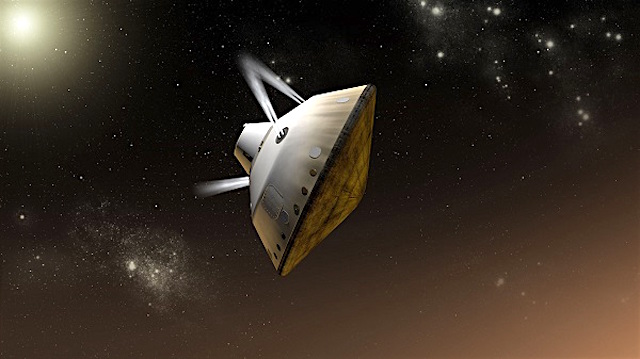 The heaviest vehicle to successfully land on Mars is the Curiosity Rover at 1 metric ton, about 2,200 pounds. Sending more ambitious robotic missions to the surface of Mars, and eventually humans, will require landed payload masses in the 5- to 20-ton range. To do that, we need to figure out how to land more mass. That was the goal of a recent study [published in the Journal of Spacecraft and Rockets].
The heaviest vehicle to successfully land on Mars is the Curiosity Rover at 1 metric ton, about 2,200 pounds. Sending more ambitious robotic missions to the surface of Mars, and eventually humans, will require landed payload masses in the 5- to 20-ton range. To do that, we need to figure out how to land more mass. That was the goal of a recent study [published in the Journal of Spacecraft and Rockets].
Normally, when a vehicle enters the Mars atmosphere at hypersonic speeds of about Mach 30, it slows down quickly, deploys a parachute to slow down more then uses rocket engines or air bags to finish the landing.
“Unfortunately, parachute systems do not scale well with increasing vehicle mass. The new idea is to eliminate the parachute and use larger rocket engines for descent,” said Zach Putnam, assistant professor in the Department of Aerospace Engineering at the University of Illinois at Urbana-Champaign.
According to Putnam, when the lander has slowed to about Mach 3, the retropropulsion engines are ignited, fired in the opposite direction to slow the vehicle down for a safe landing. The trouble is, that burns a lot of propellant. Propellant adds to vehicle mass, which can quickly drive up vehicle cost and exceed the current launch capability here on Earth. And every kilogram of propellant is a kilogram that can’t be payload: humans, science instruments, cargo, etc.
“When a vehicle is flying hypersonically, before the rocket engines are fired, some lift is generated and we can use that lift for steering,” Putnam said. “If we move the center of gravity so that it’s not uniformly packaged, but heavier on one side, it will fly at a different angle.” [More at links]








